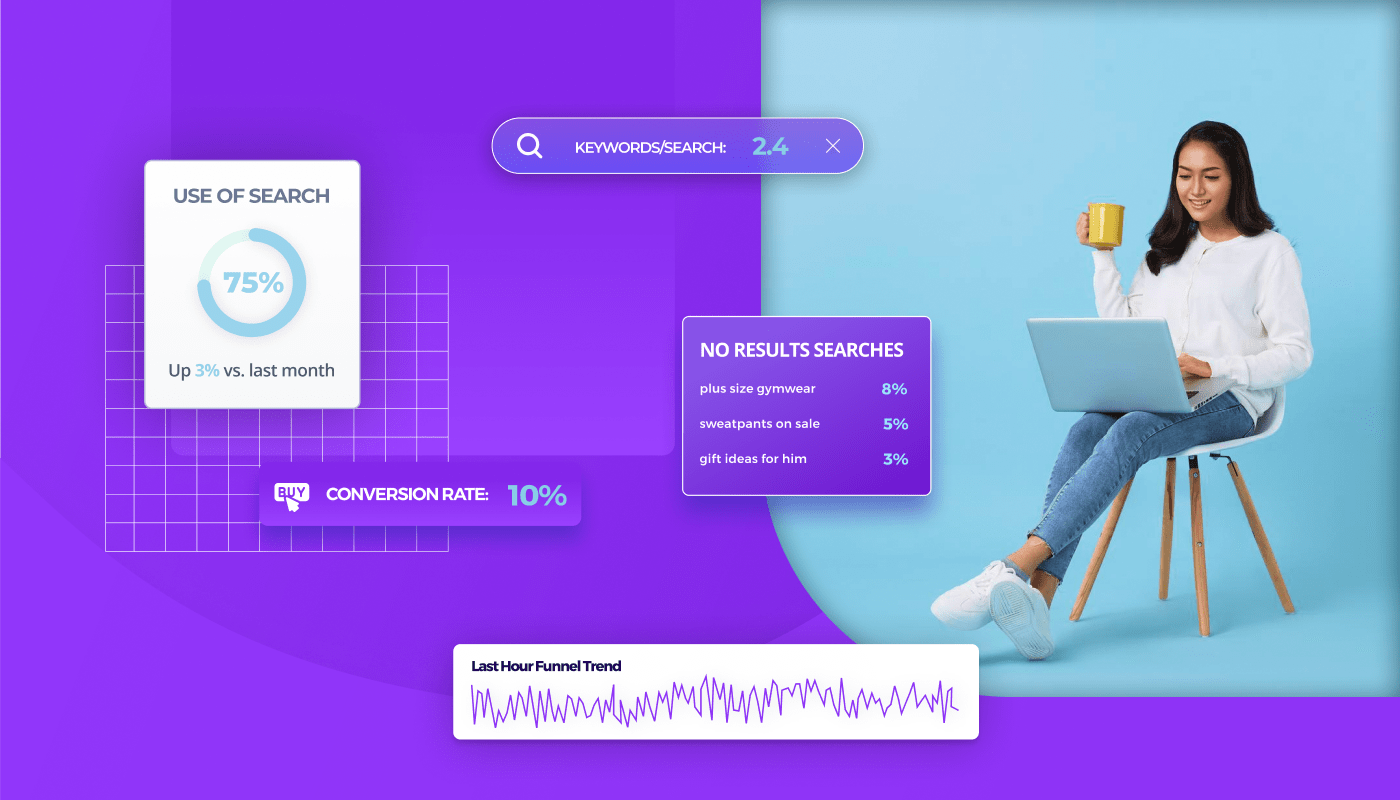Almost all retail websites have a search bar to aid users in finding the products or content they’re looking for. Adding a basic search bar to your website is easy enough, but is that all it takes to have a competitive edge? To understand whether you are effectively helping your customers find what they are looking for, you must know if your search genuinely benefits users and, ultimately, your company.
Since the famous ‘jam experiment’ proved 20+ years ago, choice overload is a conversion killer. In the case of jams laid out by 2 Columbia professors, having 4 times as many options meant people were 10x less likely to make a purchase. To make sure your customers find what they’re looking for and that your search engine positively serves your bottom line, a continuous audit of key performance indicators is required.
Here are 5 metrics you should be tracking for an exceptional site search experience:
1. Search Volume.
The share of visitors using on-site search is the most basic metric to track as an overall trend. On average, 43% of visitors go straight to the search box on retail websites. Users who engage with your site search can be characterized as having strong purchase intent since they are seeking to find specific items. This makes tracking the search volume critical to understand how your search box is performing. If there is a drop, along with your conversion rates, it would be a clear red flag to look into. Otherwise, it might indicate that you have improved product visibility and that your customers are better able to find products on your website without having to use the search function.
According to a Forrester study, 68% of users don’t return to a website after having a bad search experience. To provide your customers with a frictionless search experience, you can start by closely monitoring search queries and keywords with a high search volume. You can then adjust searchandising techniques to increase the relevance of results and improve the visibility of products that correspond to keywords with a high search volume.
You can gain valuable knowledge about the popularity of particular keywords and how it changes over the course of the year by tracking their search volume.
You may also want to analyze the channel breakdown of your search volume. This will help you understand how your site search is performing across different channels. For instance, if 50% of desktop visitors but only 20% of mobile visitors are using your site search, this discrepancy can point to an issue in your mobile search experience. Although search volume is a good starting point, it can be a very general indicator. Search volume should ideally be combined with other data such as conversion rate in order to paint a clearer image.
2. Search Engagement.
After looking into whether customers are using your search bar, it is important to understand whether they are engaging with the results you offer. The click-through rate (CTR), which is the percentage of users who actually clicked on a search result, can be utilized as an engagement metric. In general, the higher your search CTR the happier your users are with the results. If your site’s search results have a poor CTR, it is likely that users were unable to reach what they were looking for and potentially went elsewhere. Tracking your on-site CTR and search abandonment can help you identify issues in your search results such as a lack of relevance or too many promotional banners causing banner blindness.
It is crucial to continuously improve the relevance and usability of your on-site search to decrease search abandonment.
It is also useful to understand what page element visitors are clicking on. Are they interacting with different filters to further narrow down search results, or clicking on the promoted products/banners? Understanding which specific components your customers are engaging with can help you uncover CTR optimization opportunities. You can then focus on improving non-standard product elements on the page to further boost engagement.
3. Search Conversion.
It is important to quantify how much your site search experience is contributing towards the ultimate goal of conversion. On ecommerce websites, users who use site search are more likely to make purchases. In fact, site search can increase conversion rates by up to 50% over average. According to a survey by eConsultancy, site search users converted at a rate of 4.63% while the average conversion rate for all websites was calculated as 2.77%.
A comparison of site search users with the rest of your visitors in terms of add-to-cart rate, checkout and average order value (AOV) directly reveals your search ROI.
If the conversion rate for site searchers is not higher, this may indicate that your search is not providing any added value. Looking at conversion dimensions can help you drive key insights for your searchandising strategy. For instance, if your AOV for site searchers is lower than the rest of your visitors this might mean that cheaper items are appearing at the top of your search results. In this case, you can use dynamic ranking to bring forward items with a higher value. Similarly, if site searchers are adding fewer items, you can integrate bundle suggestions into your search results to encourage customers to diversify their cart.
4. Search Quality.
Analyzing quality indicators can help you learn more about the effectiveness of your search engine. One of those indicators is the number of times visitors end up on the no results page. Never say no, as the saying goes, especially to site visitors who come to buy. It is important to review no-results searches and configure alternatives either by broadening results or providing search suggestions. While it’s true that irrelevant results can turn away customers, suggesting the closest matches instead of showing a blank page can increase the likelihood of conversion and provide the customer with a more positive experience.
The underlying reason that 10% to 25% of all queries result in a page with no results is that search engines frequently struggle to understand language.
Your visitors could be converting, but finding what they need may be taking them longer than it is supposed to. This has to do with the relevance of your results and can be identified by looking at the time spent after search. If users are spending too much time going through the results it could mean they are engaged, but it could also mean they are not seeing what they need. In such cases, it is important to focus on relevance rather than trying to present as many products as possible in your search results. Combine it with the outcome KPIs to effectively evaluate what is going on.
The average rank of clicked results also ideally needs to be a low number. If it is too high, it means you are not prioritizing what the customer is looking for in the results, and making changes to your ranking algorithm is necessary. Friction in your search experience can make switching to competitors easy, it is important to focus on improving your search quality and providing your customers with a lean experience.
5. Search Behavior.
To differentiate your site search experience, you must understand the unique search behavior of different visitor segments. Search behavior can differ greatly across websites based on factors such as age, gender, location, and shopping habits of target customers.
You need to deep dive into search behavior by customer groups and look at the number of keywords per search, and the % of simple vs. complex queries.
If most of your users are conducting complex search queries such as ‘short blue summer dress size S’, it can be beneficial to invest in improving your auto-filtering and augmenting your NLP to understand these queries and present relevant results. Alternatively, if your customers are using simpler terms such as ‘blue dress’, you might want to offer facets that can help your customers narrow down search results to promptly reach what they are looking for. In such cases, you can also make sure your synonyms cover all the bases so that users will find what they are looking for no matter what synonym of the item they are using.
Search behavior may change during certain periods or seasons. It is crucial to understand how your customers behave during those times to provide a top-notch search experience all year round.
Final Thoughts
A 2021 Google Cloud study estimates losses from search abandonment to be around $300 billion a year in the US alone for online retailers. Since visitors are essentially typing out what they want, there is great potential to be gained by improving the on-site search experience and defending this value against competitors. Your on-site search data can help you gain insights into shopper demands, behavior, and existing issues. By knowing what they’re searching for and how successful they are at finding it, you can optimize the experience and positively impact your bottom line.
In addition to aligning with best practices, it is important to localize existing challenges and understand the specific factors that are driving shoppers away. With effective search intelligence, you can quickly spot issues and start working on them before it is too late.



